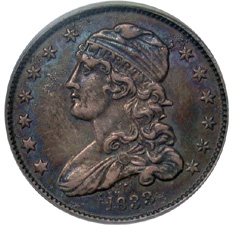
The Capped Bust Quarter was minted in two subtypes, which carry different specifications. The first variety, known as “Large Diameter,” was issued from 1815 to 1828. The second variety, known “Reduced Diameter” or “Motto Removed,” was issued from 1831 to 1838.
Subtype 1
Coins of the first subtype were struck on planchets with specifications matching the earlier series of Draped Bust Quarters. Struck from a composition of 89.24% silver and 10.76% copper, the coins carried a standard weight 6.74 grams (104 grains) and diameter of 27 mm. All coins were struck with a reeded edge.
Capped Bust Quarters of the second variety are usually better produced than the first, which were struck on older machinery, under more difficult circumstances. Striking problems may be apparent on coins of the first type, while the second types come unusually well struck for the era. Across both varieties and all grade levels, careful examination of coins is recommended to identify premium quality pieces which have not been cleaned, damaged, or otherwise impaired.
Subtype 2
Coins of the second subtype had the same composition, weight, and reeded edge, however the diameter was reduced to 24.3 millimeters. Starting in 1837, the composition was modified to 90% silver and 10% copper, with a weight of 6.68 grams.

